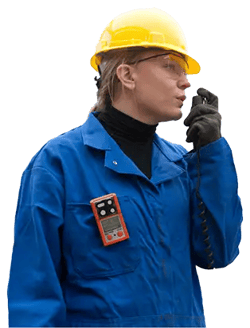Equipped with the latest, most accurate PID sensing technology from ION Science, the Ventis Pro5 from Industrial Scientific is now the most compact, versatile, and connected five-gas personal monitor available to reliably detect volatile organic compounds (VOCs). However, if you're considering adding the Ventis Pro5 with PID sensor to your fleet of gas monitoring equipment, there's a lot to consider about what's best for you and your facility—including why, how, what, where, and when to use this option for gas detection.
Join Ilaria Tramelli, business development director PID at Industrial Scientific, and Peter Morris, head of sensors at ION Science, as they discuss common applications and industries where PID monitoring is used.

Interested in learning more about PID technology? Click here to watch the full conversation between Industrial Scientific and ION Science.
Video Transcript
Moderator: Would you go into detail on some of the main applications where PID technology is used?
Tramelli: Sure. The main sector covered by PID is the oil and gas sector. This is because crude oil is a complex mixture of VOCs that are all toxic at ppm levels, as we have previously discussed. So to monitor the workers' exposure in this industry is really, really important. During normal operations, workers can be exposed to leaks coming from pumps, valves, flanges, storage tanks or during loading, and unloading operations.
During shutdown, as lines and reaction vessels are opened, they pose a significant risk of over-exposure, without appropriate control measures. Concentrations can be several hundred (or even thousands) times higher than the occupational exposure limit.
The petrochemical sector is another industry where we can find VOCs because petrochemicals are defined as chemicals that are created through the process of refining petroleum (crude oil) and are used as building-blocks for a wide range of materials. Some examples of petrochemicals are butadiene that is used in making synthetic rubber, benzene that is the raw material for dyes and synthetic detergents, and benzene and toluene are used in making polyurethanes. Xylenes are used to produce plastics and synthetic fibers. Vinylchloride is among the top 20 largest petrochemicals in world production and it’s used to produce PVC. Vinylchloride is flammable, toxic, and carcinogenic, and it’s a VOC that can be detected by PID.
Chemical plants are a sector covered by PID application as well. Because VOCs often have good properties to be used as solvents (such as liquids, in which other materials dissolve to form a solution). All the chemical processes use solvents and these products can release organic compounds while they are being used, and, to some degree, when they are stored.
PID sensors can really help hazmat response teams. Why? Because many hazardous materials incidents involve VOCs. When a hazmat response team arrives at the scene of any incident or accident involving hazardous materials, there are many unknown factors which initially need to be identified, so it is critical that first responders tackle each incident in an accurate and systematic way. The ability of a PID to measure low levels (ppm) of VOCs makes them a vital tool in the decision making process following a hazmat incident.
Although PID is not specific in terms of gas selection, its continuous and almost instant response rate enables first responders to carry out their jobs secure in the knowledge that their exposure to hazardous chemicals is limited. PID is also a great sensor for all the companies that offer consultancy services to reduce the environmental risk such as environmental monitoring, contaminated land and water assessment, and remediation. Due to the fact that VOCs include hundreds of compounds, there are many other sectors that can be covered by PID application.
Morris: I just want to add that VOCs are present outside of industrial areas. The importance of good urban air quality, especially indoor air quality since the pandemic, has become more of a focus for citizens, local authorities, and the private sector. The World Health Organization data shows that almost all of the global population breathe in air that exceeds guideline limits, with low and middle income countries suffering from the worst exposures. And WHO estimates the combined effects of air pollution and household pollution is associated with over 7 million premature deaths annually.
Traditional methods for measuring air quality cost on the order of tens to hundreds of thousands of pounds (or dollars), and they're fantastically accurate. But because they're expensive, they can only be installed in a few locations and they only take samples every every hour or every couple of hours. Recently, low-cost air quality monitoring stations utilizing PID, alongside other techniques, have been used in high-density monitoring programs.
These have highlighted pollution levels can vary temporally. They vary on the order of minutes and they vary spatially. The concentrations can be very different from, say, one road junction to another road junction. So on the order of tens to hundreds of meters. By using a low-cost air quality network, local and even mobile sources of pollution can be identified and allows the possibility of real-time reactions to pollution events.
So, for example, you could manage traffic in hot spots, you could divert traffic around when pollution levels get too high, and you can suggest preferential walking routes for schoolchildren. You can also identify emitters to help with reducing VOC concentrations long term, and I'm expecting to see a much wider spread adoption of low-cost air quality monitoring networks in more and more cities in the near future.
Interested in learning more about PID technology? Click here to watch the full conversation between Industrial Scientific and ION Science.



